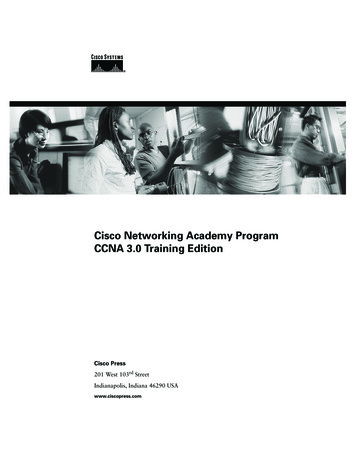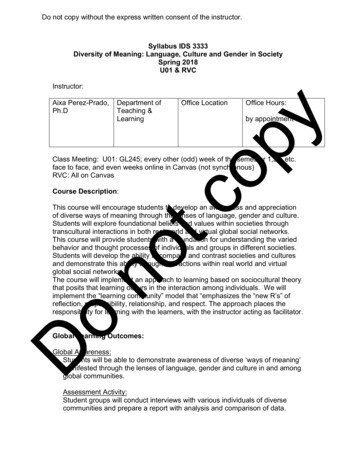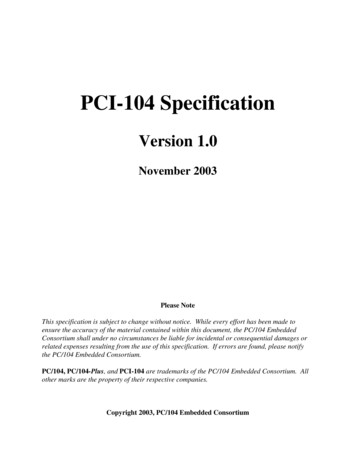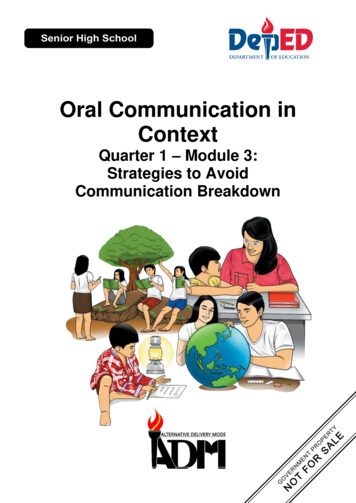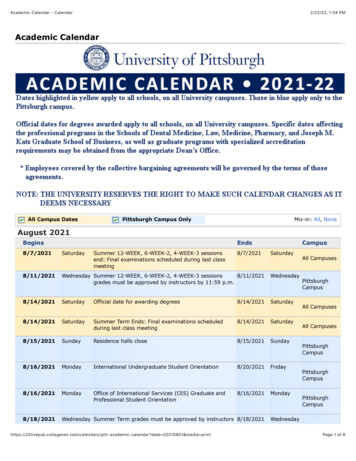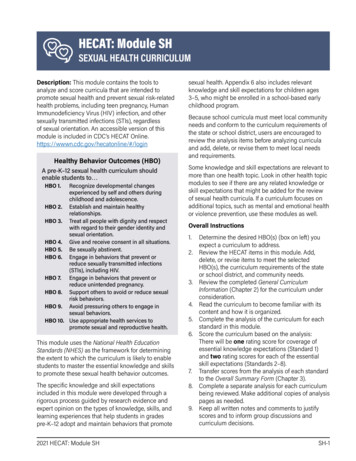
Transcription
HECAT: Module SHSEXUAL HEALTH CURRICULUMDescription: This module contains the tools toanalyze and score curricula that are intended topromote sexual health and prevent sexual risk-relatedhealth problems, including teen pregnancy, HumanImmunodeficiency Virus (HIV) infection, and othersexually transmitted infections (STIs), regardlessof sexual orientation. An accessible version of thismodule is included in CDC’s HECAT lthy Behavior Outcomes (HBO)A pre-K–12 sexual health curriculum shouldenable students to HBO 1.Recognize developmental changesexperienced by self and others duringchildhood and adolescence.HBO 2. Establish and maintain healthyrelationships.HBO 3. Treat all people with dignity and respectwith regard to their gender identity andsexual orientation.HBO 4. Give and receive consent in all situations.HBO 5. Be sexually abstinent.HBO 6. Engage in behaviors that prevent orreduce sexually transmitted infections(STIs), including HIV.HBO 7. Engage in behaviors that prevent orreduce unintended pregnancy.HBO 8. Support others to avoid or reduce sexualrisk behaviors.HBO 9. Avoid pressuring others to engage insexual behaviors.HBO 10. Use appropriate health services topromote sexual and reproductive health.This module uses the National Health EducationStandards (NHES) as the framework for determiningthe extent to which the curriculum is likely to enablestudents to master the essential knowledge and skillsto promote these sexual health behavior outcomes.The specific knowledge and skill expectationsincluded in this module were developed through arigorous process guided by research evidence andexpert opinion on the types of knowledge, skills, andlearning experiences that help students in gradespre-K–12 adopt and maintain behaviors that promote2021 HECAT: Module SHsexual health. Appendix 6 also includes relevantknowledge and skill expectations for children ages3–5, who might be enrolled in a school-based earlychildhood program.Because school curricula must meet local communityneeds and conform to the curriculum requirements ofthe state or school district, users are encouraged toreview the analysis items before analyzing curriculaand add, delete, or revise them to meet local needsand requirements.Some knowledge and skill expectations are relevant tomore than one health topic. Look in other health topicmodules to see if there are any related knowledge orskill expectations that might be added for the reviewof sexual health curricula. If a curriculum focuses onadditional topics, such as mental and emotional healthor violence prevention, use these modules as well.Overall Instructions1.2.3.4.5.6.7.8.9.Determine the desired HBO(s) (box on left) youexpect a curriculum to address.Review the HECAT items in this module. Add,delete, or revise items to meet the selectedHBO(s), the curriculum requirements of the stateor school district, and community needs.Review the completed General CurriculumInformation (Chapter 2) for the curriculum underconsideration.Read the curriculum to become familiar with itscontent and how it is organized.Complete the analysis of the curriculum for eachstandard in this module.Score the curriculum based on the analysis:There will be one rating score for coverage ofessential knowledge expectations (Standard 1)and two rating scores for each of the essentialskill expectations (Standards 2–8).Transfer scores from the analysis of each standardto the Overall Summary Form (Chapter 3).Complete a separate analysis for each curriculumbeing reviewed. Make additional copies of analysispages as needed.Keep all written notes and comments to justifyscores and to inform group discussions andcurriculum decisions.SH-1
Standard 1The Standard 1 curriculum analysis will result in asingle score that reflects the extent to which thecurriculum addresses the knowledge required toachieve the selected Healthy Behavior Outcomesrelated to sexual health (HBOs, page SH-1). The HECATlists the essential knowledge expectations to becompleted by grades 2, 5, 8, and 12. These are listedby grade span: pre-K–2; 3–5; 6–8; and 9–12, startingon page SH-3. The relationship of each knowledgeexpectation to a HBO is identified following eachexpectation in parentheses.The knowledge expectations are numbered sequentially for the ease of identification and discussion.Before each knowledge expectation, the numberrepresents topic abbreviation, NHES standard number,grade span (last grade in that span), and knowledgeexpectation item number. For example, SH1.5.1 wouldrepresent Sexual Health, standard 1, grade span 3–5,knowledge expectation item 1.3.4.Directions for Standard 11.Review the knowledge expectations (pages SH-3through SH-13).2. Decide if any of the knowledge expectations needto be deleted or modified or if any additionalknowledge expectations should be added tomeet the needs of the community or to conformto the curriculum requirements of the state orschool district. Review other standards beforemaking changes to the knowledge expectationsin Standard 1. Some relevant knowledge expectations may be reflected in the skill expectations inStandards 2–8, and some might be found in otherhealth topic modules. Look in other related topicmodules for those that might be edited and addedto the list of knowledge expectations for this topic.5.6.7.8.For example, if a curriculum speaks to broadersexual health issues including outcomes such asexpressing feelings in a healthy way, maintaininghealthy relationships, getting help to stop orprevent sexual violence or abuse, and preventingspread of infectious disease, include the knowledge expectations that address these outcomes inthe mental and emotional health, personal healthand wellness, and violence prevention modules.Read the curriculum to become familiar with itscontent, the information provided for students,and the methods used to convey information andknowledge content.Place a check in the box next to each knowledgeexpectation that is addressed by the curriculumand determine the Knowledge ExpectationsCoverage Score. Important—a knowledgeexpectation is “addressed” if there is sufficientinformation provided in the curriculum forstudents to be able to demonstrate understandingof this concept. Some knowledge expectationsmight require more evidence than others.Transfer the Knowledge Expectations CoverageScore to the appropriate line on the OverallSummary Form (Chapter 3).Record notes to justify scores and to inform groupdiscussions and curriculum decisions.Analyze Standard 1 for each curriculum beingreviewed. If the curriculum addresses more thanone grade span, complete a separate analysis ofStandard 1 for each span.Complete a separate Overall Summary Form foreach curriculum and grade span.Instructions for Standards 2–8 are provided on page SH–14.SH-22021 HECAT: Module SH
Standard1 Knowledge ExpectationsGrades Pre-K–2Students will comprehend concepts related tohealth promotion and disease prevention.After implementing this curriculum, students will comprehend concepts importantto promote sexual health.Grades Pre-K–2 Knowledge Expectations: Check the box next to each sexual health-related knowledgeexpectations added and addressed in the curriculum.By grade 2, students will be able to: SH1.2.1 SH1.2.2 SH1.2.3Use medically accurate terms for body parts, including genitals. (HBO 1) SH1.2.4 SH1.2.5Identify the benefits of healthy peer relationships. (HBO 2) SH1.2.6Describe how to say ‘yes’ and ‘no’ to people, behaviors, or situations that could make one feeluncomfortable or unsafe. (HBO 2 & 4) SH1.2.7 SH1.2.8Identify different ways that disease-causing germs are transmitted. (HBO 6)Identify the benefits of healthy family or caregiver relationships. (HBO 2)Recognize the range of different family and peer relationships (e.g., nuclear, single parent, blended,intergenerational, cohabiting, adoptive, foster, same sex or gender). (HBO 2 & 3)Explain why it is wrong to tease or bully others based on personal characteristics (e.g., sex, race, ethnicity,culture, sexual orientation, appearance, abilities, mannerisms, the way one dresses or acts). (HBO 3)Identify ways to prevent the spread of germs that cause infectious diseases. (HBO 6)Additional Knowledge Expectations KNOWLEDGE EXPECTATIONS COVERAGE SCORING: Complete the score based on the criteria listed below.The curriculum addresses:4 all of the knowledge expectations. (100%)3 most of the knowledge expectations. (67–99%)2 some of the knowledge expectations. (34–66%)1 a few of the knowledge expectations. (1–33%)0 none of the knowledge expectations. (0)KNOWLEDGE EXPECTATIONS COVERAGE SCORETRANSFER THIS SCORE TO THE KNOWLEDGE EXPECTATIONS LINEOF THE OVERALL SUMMARY FORM (CHAP. 3).Notes:Reminder: The HECAT is designed to guide the analysis of curricula for local use. Users are encouraged to add, delete, orrevise knowledge expectations to reflect community needs and to meet the curriculum requirements of the school district.2021 HECAT: Module SHSH-3
Knowledge ExpectationsStandard1Grades 3–5Students will comprehend concepts related tohealth promotion and disease prevention.After implementing this curriculum, students will comprehend concepts importantto promote sexual health.Grades 3–5 Knowledge Expectations: Check the box next to each sexual health-related knowledgeexpectation addressed in the curriculum.By grade 5, students will be able to: SH1.5.1 SH1.5.2 SH1.5.3 Explain how puberty and development can vary greatly and be normal. (HBO 1, 6, 7 & 10)Describe internal and external reproductive body parts using medically accurate terms in a gender-neutralway (e.g., some people have a penis and some people have a vagina). (HBO 1, 6, 7 & 10)SH1.5.4Define gender identity and expression. (HBO 3)SH1.5.5Explain the difference between sex assigned at birth and gender identity and expression. (HBO 1 & 3)SH1.5.6Describe gender roles and expectations and how they can influence relationships. (HBO 3)SH1.5.7Define sexual orientation (i.e., patterns of emotional, romantic, or sexual attractions to men, women, orboth sexes), including sense of identity, attractions, and related behaviors (e.g., heterosexual, gay/lesbian,bisexual). (HBO 3) SH1.5.8 SH1.5.9 Describe the physical, cognitive, emotional, and social changes that occur during puberty. (HBO 1, 6, 7 & 10)Describe the differences between sexual orientation and gender identity and expression. (HBO 3)Describe personal characteristics related to sexual identity, orientation, and gender that make peopledifferent from one another. (HBO 3)SH1.5.10Identify characteristics of healthy relationships. (HBO 2)SH1.5.11Describe the benefits of healthy family or caregiver relationships. (HBO 2)SH1.5.12Describe the benefits of healthy peer relationships. (HBO 2)SH1.5.13List healthy ways to express affection, love, and friendship. (HBO 2)SH1.5.14Identify characteristics of a responsible family member or caregiver. (HBO 2)SH1.5.15Recognize the range of different family and peer relationships (e.g., nuclear, single parent, blended,intergenerational, cohabiting, adoptive, foster, same sex or gender). (HBO 2 & 3) SH1.5.16Summarize why it is wrong to tease or bully others based on gender identity, sexual orientation, or otherpersonal characteristics (e.g., sex, race, ethnicity, culture, appearance, abilities, mannerisms, the way onedresses or acts). (HBO 3) SH1.5.17 SH1.5.18Describe consent and its importance in all relationships. (HBO 2, 3 & 4)Describe how to say ‘yes’ and ‘no’ to people, behaviors, or situations that could make one feeluncomfortable or unsafe. (HBO 2 & 4) SH1.5.19 Describe ways that common infectious diseases are transmitted. (HBO 6) SH1.5.20 Describe ways to prevent the spread of germs that cause infectious diseases. (HBO 6) SH1.5.21 Explain that HIV is not easily transmitted like other common infectious diseases. (HBO 3)Promoting Sexual Health, Grades 3–5 continued on next page.SH-42021 HECAT: Module SH
Standard1 Knowledge ExpectationsGrades 3–5Students will comprehend concepts related tohealth promotion and disease prevention.After implementing this curriculum, students will comprehend concepts importantto promote sexual health.Grades 3–5 Knowledge Expectations: Check the box next to each sexual health-related knowledgeexpectation addressed in the curriculum.By grade 5, students will be able to:Additional Knowledge Expectations KNOWLEDGE EXPECTATIONS COVERAGE SCORING: Complete the score based on the criteria listed below.The curriculum addresses:4 all of the knowledge expectations. (100%)3 most of the knowledge expectations. (67–99%)2 some of the knowledge expectations. (34–66%)1 a few of the knowledge expectations. (1–33%)0 none of the knowledge expectations. (0)KNOWLEDGE EXPECTATIONS COVERAGE SCORETRANSFER THIS SCORE TO THE KNOWLEDGE EXPECTATIONS LINEOF THE OVERALL SUMMARY FORM (CHAP. 3).Notes:Reminder: The HECAT is designed to guide the analysis of curricula for local use. Users are encouraged to add, delete, orrevise knowledge expectations to reflect community needs and to meet the curriculum requirements of the school district.2021 HECAT: Module SHSH-5
Knowledge ExpectationsStandard1Grades 6–8Students will comprehend concepts related tohealth promotion and disease prevention.After implementing this curriculum, students will comprehend concepts importantto promote sexual health.Grades 6–8 Knowledge Expectations: Check the box next to each sexual health-related knowledgeexpectations added and addressed in the curriculum.By grade 8, students will be able to: SH1.8.1 SH1.8.2 SH1.8.3Describe the physical, cognitive, emotional, and social changes that occur during puberty. (HBO 1, 6, 7 & 10) SH1.8.4 SH1.8.5Describe the relationship between the menstrual cycle and conception. (HBO 1, 7 & 10) SH1.8.6Analyze associations between a range of gender identities and expressions (e.g., cisgender, transgender,non-binary/conforming, expansive) and health. (HBO 3) SH1.8.7 SH1.8.8Differentiate between sex assigned at birth and gender identity and expression. (HBO 1 & 3) Explain how puberty and development can vary greatly and be normal. (HBO 1, 6, 7 & 10)Describe internal and external reproductive body parts using medically accurate terms in a gender-neutralway (e.g., some people have a penis and some people have a vagina). (HBO 1, 6, 7 & 10)Describe the range of gender identities and expressions (e.g., cisgender, transgender, non-binary/conforming, expansive). (HBO 3)Define sexual orientation (i.e., patterns of emotional, romantic, or sexual attractions to men, women, orboth sexes), including sense of identity, attractions, and related behaviors (e.g., heterosexual, gay/lesbian,bisexual). (HBO 3)SH1.8.9Analyze associations between sexual orientation and health. (HBO 3)SH1.8.10Describe characteristics of healthy relationships. (HBO 2)SH1.8.11Describe healthy and unhealthy relationships. (HBO 2)SH1.8.12Describe healthy ways to express affection, love, and friendship. (HBO 2, 3 & 8)SH1.8.13Explain the qualities of a healthy dating or sexual relationship. (HBO 2)SH1.8.14Describe the range of family and peer relationship structures (e.g., nuclear, single, parent, blended,intergenerational, cohabiting, adoptive, foster, same sex or gender). (HBO 2 & 3) SH1.8.15 SH1.8.16Describe the range of dating or sexual relationship structures. (HBO 2) SH1.8.17Describe how power differences (e.g., age, race/ethnicity, sex, gender, socio-economic status) impactrelationships. (HBO 2, 3, 4, 5, 6, 7, 8 & 9) SH1.8.18Describe how gender role stereotypes impact goal-setting and decision-making in relationships. (HBO 2,3, 4, 6, 7, 8 & 9) SH1.8.19Explain the negative consequences of sending sexually explicit pictures, messages, or media (e.g., texting,chat groups, social media platforms, e-mail, websites, phone or tablet applications). (HBO 2, 3, 4, 5 & 9)Explain the importance of talking with parents, caregivers, and other trusted adults about issues related togrowth and development, relationships, sex, and sexual and reproductive health services. (HBO 1, 2, 3, 4, 5,6, 7 & 10) SH1.8.20 Explain how viewing sexually explicit pictures, messages, or media can influence perceptions of, andexpectations for, relationships. (HBO 2, 4, 5, 8 & 9)Promoting Sexual Health, Grades 6–8 continued on next page.SH-62021 HECAT: Module SH
Standard1 Knowledge ExpectationsGrades 6–8Students will comprehend concepts related tohealth promotion and disease prevention.After implementing this curriculum, students will comprehend concepts importantto promote sexual health.Grades 6–8 Knowledge Expectations (continued): Check the box next to each sexual health-relatedknowledge expectations added and addressed in the curriculum.By grade 8, students will be able to: SH1.8.21Explain why it is wrong to tease or bully others based on their gender or sexuality (e.g., gender identityand expression, sexual orientation, or sexual abstinence and activity), growth and development, orphysical appearance or ability. (HBO 3) SH1.8.22 Describe how bias, prejudice, and stigma related to gender and sexuality (e.g., gender identity andexpression, sexual orientation, or sexual abstinence and activity) can impact health. (HBO 3) SH1.8.23 Explain the benefits of respecting individual differences in gender and sexuality (e.g., gender identity andexpression, sexual orientation, or sexual abstinence and activity), growth and development, or physicalappearance or ability. (HBO 3 & 8) SH1.8.24 Describe ways to show dignity and respect for all people with regard to their gender and sexuality(e.g., gender identity and expression, sexual orientation, or sexual abstinence and activity). (HBO 3) SH1.8.25 Describe stereotypes, myths, and stigma about STIs, including HIV, and people living with acquiredimmunodeficiency syndrome (AIDS). (HBO 3 & 6) SH1.8.26 Define consent and its importance for decisions about sexual behaviors. (HBO 4, 5, 6, 7 & 8) SH1.8.27 Describe how to communicate consent for all sexual behaviors. (HBO 4) SH1.8.28 Explain how to receive consent and accept a lack or retraction of consent for sexual behaviors. (HBO 4, 6,7 & 9) SH1.8.29 Describe how consent cannot be fully present when there is an imbalance of power. (HBO 2 & 4) SH1.8.30 Explain why a person who has experienced any form of sexual violence (e.g., sexual harassment, sexualassault, incest, rape, domestic violence, coercion, and dating violence) is never to blame for actions of theperpetrator. (HBO 2, 4 & 9) SH1.8.31Describe how a person can call attention to or leave an uncomfortable and dangerous situation, includinginstances of sexual violence. (HBO 8 & 9) SH1.8.32 Explain the importance of setting personal limits to avoid sexual risk behaviors. (HBO 2, 4, 5, 6, 7 & 8) SH1.8.33 Describe the benefits of being sexually abstinent. (HBO 5) SH1.8.34 Describe why sexual abstinence is the safest, most effective risk avoidance method of protection fromSTIs, including HIV, and unintended pregnancy. (HBO 5, 6 & 7) SH1.8.35 Describe the factors that protect against engaging in sexual risk behaviors. (HBO 2, 3, 4, 5, 6 & 7)SH1.8.36 Describe the factors that contribute to engaging in sexual risk behaviors. (HBO 2, 3, 4, 5, 6 & 7)SH1.8.37Analyze ways common infectious diseases are transmitted. (HBO 6)SH1.8.38 Explain how the most common STIs, including HIV, are transmitted. (HBO 6)SH1.8.39 Describe usual signs and symptoms of the most common STIs and HIV. (HBO 6)SH1.8.40 Explain the short- and long-term consequences of common STIs. (HBO 6)SH1.8.41Summarize which STIs can be cured and which can be treated. (HBO 6)SH1.8.42 Describe the effectiveness of condoms in reducing the risk of HIV and other STIs (e.g., chlamydia, syphilis).(HBO 6)Promoting Sexual Health, Grades 6–8 continued on next page.2021 HECAT: Module SHSH-7
Knowledge ExpectationsStandard1Grades 6–8Students will comprehend concepts related tohealth promotion and disease prevention.After implementing this curriculum, students will comprehend concepts importantto promote sexual health.Grades 6–8 Knowledge Expectations (continued): Check the box next to each sexual health-relatedknowledge expectations added and addressed in the curriculum.By grade 8, students will be able to: SH1.8.43 Describe how pre-exposure prophylaxis (PrEP) and post-exposure prophylaxis (PEP) are safe and effectiveways to prevent HIV infection and transmission. (HBO 6) SH1.8.44 Describe the role of HIV treatment in preventing HIV transmission. (HBO 6) SH1.8.45 Summarize ways to decrease the spread of STIs and HIV by not having sex, using condoms consistentlyand correctly when having sex, using PrEP, getting treatment for HIV and STIs, not touching blood or usinghypodermic needles. (HBO 6) SH1.8.46 Describe ways sexually active people can reduce the risk of unintended pregnancy. (HBO 7) SH1.8.47 Describe the effectiveness of condoms in reducing the risk of unintended pregnancy. (HBO 7) SH1.8.48 Describe methods of birth control (e.g., intrauterine device (IUD) or implant, shot, patch, ring, birth controlpills, condoms, emergency contraception) including their effectiveness, required user action, and possibleside effects. (HBO 6 & 7) SH1.8.49 Describe the importance of using a condom for STI/HIV prevention at the same time as using a moreeffective contraceptive method (i.e., IUD or implant, shot, patch, ring, birth control pills) for pregnancyprevention. (HBO 6 & 7) SH1.8.50 Explain the importance of using a condom for STI prevention at the same time as using other effective HIVprevention options including antiretroviral therapy (ART), PrEP, or PEP. (HBO 6) SH1.8.51Explain why the most effective contraceptive methods (i.e., IUD or implant, shot, patch, ring, birth controlpills) do not prevent STIs, including HIV. (HBO 6 & 7) SH1.8.52 Summarize ways to prevent unintended pregnancy, including not having sex and effective use ofcontraceptives. (HBO 2, 5, 6 & 7) SH1.8.53 Identify the emotional, social, physical, and financial effects of becoming a parent. (HBO 7) SH1.8.54 Describe what confidential care is and give specific instances when confidential care cannot bemaintained. (HBO 6, 7 & 10) SH1.8.55 Describe young people’s rights to confidential services in their state. (HBO 3, 4, 6, 7 & 10) SH1.8.56 Describe young people’s legal rights to consent to sexual and reproductive health services, including STI/HIV testing, treatment (including ART, PrEP, PEP), and contraception. (HBO 6, 7 & 10) SH1.8.57 Explain what to expect from youth-friendly sexual health services and providers (e.g., hours, use ofpreferred names and pronouns). (HBO 6, 7 & 10) SH1.8.58 Describe the importance of ‘time-alone’ between young people and the healthcare provider (e.g., doctor,nurse) to discuss sexual and reproductive health and other sensitive health topics. (HBO 4, 6, 7 & 10) SH1.8.59 Explain the importance of disclosing sexual activity to a healthcare provider. (HBO 6, 7 & 10)Promoting Sexual Health, Grades 6–8 continued on next page.SH-82021 HECAT: Module SH
Standard1 Knowledge ExpectationsGrades 6–8Students will comprehend concepts related tohealth promotion and disease prevention.After implementing this curriculum, students will comprehend concepts importantto promote sexual health.Grades 6–8 Knowledge Expectations (continued): Check the box next to each sexual health-relatedknowledge expectations added and addressed in the curriculum.By grade 8, students will be able to: SH1.8.60 Explain the importance of preventative care including examinations, checkups, immunizations, and healthscreenings (e.g., breast and testicular self-examination, Pap smears, PrEP and PEP) needed to maintainsexual and reproductive health. (HBO 10) SH1.8.61Describe how the human papillomavirus (HPV) vaccination is a safe and effective way to avoid HPVinfection, cancer, and other related health issues. (HBO 6 & 10)Additional Knowledge Expectations KNOWLEDGE EXPECTATIONS COVERAGE SCORING: Complete the score based on the criteria listed below.The curriculum addresses:4 all of the knowledge expectations. (100%)3 most of the knowledge expectations. (67–99%)2 some of the knowledge expectations. (34–66%)1 a few of the knowledge expectations. (1–33%)0 none of the knowledge expectations. (0)KNOWLEDGE EXPECTATIONS COVERAGE SCORETRANSFER THIS SCORE TO THE KNOWLEDGE EXPECTATIONS LINEOF THE OVERALL SUMMARY FORM (CHAP. 3).Notes:Reminder: The HECAT is designed to guide the analysis of curricula for local use. Users are encouraged to add, delete, orrevise knowledge expectations to reflect community needs and to meet the curriculum requirements of the school district.2021 HECAT: Module SHSH-9
Knowledge ExpectationsStandard1Grades 9–12Students will comprehend concepts related to healthpromotion and disease prevention.After implementing this curriculum, students will comprehend concepts importantto promote sexual health.Grades 9–12 Knowledge Expectations: Check the box next to each sexual health-related knowledgeexpectations added and addressed in the curriculum.By grade 12, students will be able to: SH1.12.1 SH1.12.2Explain how puberty and development can vary greatly and be normal. (HBO 1, 6, 7 & 10) SH1.12.3 SH1.12.4 SH1.12.5Summarize the relationship between the menstrual cycle and conception. (HBO 1, 7 & 10) SH1.12.6Analyze associations between a range of gender identities and expressions (e.g., cisgender, transgender,non-binary/conforming, expansive) and health. (HBO 3) SH1.12.7 SH1.12.8Differentiate between sex assigned at birth and gender identity and expression. (HBO 1 & 3) SH1.12.9Describe internal and external reproductive body parts using medically accurate terms in a gender-neutralway (e.g., some people have a penis and some people have a vagina). (HBO 1, 6, 7 & 10)Describe the human sexual response cycle, including the role of hormones and pleasure. (HBO 1)Describe the range of gender identities and expressions (e.g., cisgender, transgender, non-binary/conforming, expansive). (HBO 3)Describe sexual orientation (i.e., patterns of emotional, romantic, or sexual attractions to men, women, orboth sexes), including sense of identity, attractions, and related behaviors (e.g., heterosexual, gay/lesbian,bisexual). (HBO 1 & 3)Analyze associations between sexual orientation and health. (HBO 1 & 3)SH1.12.10 Analyze characteristics of healthy relationships. (HBO 2)SH1.12.11Summarize the qualities of a healthy dating or sexual relationship. (HBO 2)SH1.12.12 Explain how to build and maintain healthy family and peer relationships. (HBO 2)SH1.12.13 Describe the range of family and peer relationship structures and dynamics (e.g., nuclear, single parent,blended, intergenerational, cohabiting, adoptive, foster, same sex or gender). (HBO 2 & 3) SH1.12.14 Describe the range of dating and sexual relationship structures. (HBO 2) SH1.12.15 Summarize the importance of talking with parents, caregivers, and other trusted adults about issues relatedto growth and development, relationships, sex, and sexual and reproductive health services. (HBO 1, 2, 3, 4,5, 6, 7 & 10) SH1.12.16 Analyze how power differences (e.g., age, race/ethnicity, sex, gender, socio-economic status) impactrelationships. (HBO 2, 3, 4, 6, 7, 8 & 9) SH1.12.17 Examine how gender role stereotypes impact goal-setting and decision-making in relationships. (HBO 2, 3,4, 6, 7, 8 & 9) SH1.12.18 Explain the negative consequences of sending sexually explicit pictures, messages, or media (e.g., e-mail,texting, chat groups, social media platforms, websites, phone and tablet applications). (HBO 2, 3 & 9) SH1.12.19 Explain how viewing sexually explicit pictures, messages, or media can influence perceptions of, andexpectations for, relationships. (HBO 2, 3 & 9) SH1.12.20 Analyze the impact of technology and social media on peer, dating, and sexual relationships. (HBO 2, 3, 4, 6,7, 8 & 9)Promoting Sexual Health, Grades 9–12 continued on next page.SH-102021 HECAT: Module SH
Standard1 Knowledge ExpectationsGrades 9–12Students will comprehend concepts related tohealth promotion and disease prevention.After implementing this curriculum, students will comprehend concepts importantto promote sexual health.Grades 9–12 Knowledge Expectations (continued): Check the box next to each sexual health-relatedknowledge expectations added and addressed in the curriculum.By grade 12, students will be able to: SH1.12.21 Evaluate effective strategies for dealing with difficult relationships with family members, peers, and datingor sexual partners. (HBO 2) SH1.12.22 Summarize why it is wrong to tease or bully others based on their gender and sexuality (e.g., genderidentity or expression, sexual orientation, sexual abstinence and activity). (HBO 7) SH1.12.23 Summarize how bias, prejudice, and stigma related to gender and sexuality (e.g., gender identity andexpression, sexual orientation, or sexual abstinence and activity) can impact health. (HBO 2 & 3) SH1.12.24 Summarize the benefits of respecting individual differences in gender and sexuality (e.g., gender identityand expression, sexual orientation, or sexual abstinence and activity), growth and development, or physicalappearance or ability. (HBO 2 & 3) SH1.12.25 Summarize ways to show dignity and respect for all people with regard to their gender and sexuality(e.g., gender identity or expression, sexual orientation, sexual abstinence and activity). (HBO 2 & 3) SH1.12.26 Analyze stereotypes, myths, and stigma about STIs, including HIV, and people living with AIDS. (HBO 3 & 6)SH1.12.27 Define consent and its importance for decisions about sexual behaviors. (HBO 2, 4, 6, 7 & 8)SH1.12.28 Summarize why individuals have the right to refuse sexual contact. (HBO 4, 5 & 9)SH1.12.29 Explain why it is an individual’s responsibility to verify that all sexual contact is consensual. (HBO 2 & 4)SH1.12.30 Describe how
knowledge expectation item 1. Directions for Standard 1 1. Review the knowledge expectations (pages SH-3 through SH-13). 2. Decide if any of the knowledge expectations need to be deleted or modified or if any additional knowledge expectations should be added to meet the needs of the community or to conform to the curriculum requirements of the .




